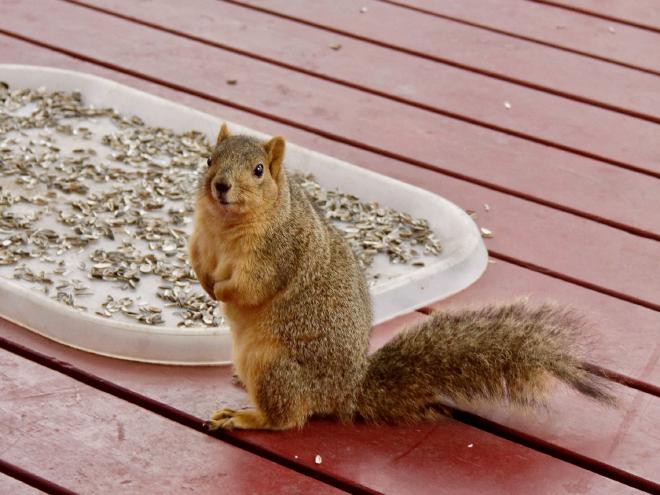A fluffy tale

Squirrels don’t hibernate during winter, but they do slow down their metabolism to conserve energy. Research suggests that their immune systems partially shut down as a result. Perhaps for this reason, squirrels often develop mange in winter.
Our resident alpha squirrel, Blacktip, developed a bad case of fur loss over winter. It started on his neck and chest, but soon spread to his belly and thighs, leaving him pink and itchy. Apparently squirrels usually recover on their own once spring arrives, but this particular critter showed no signs of getting better. I took the feed box away so he wouldn’t spread whatever it was to the other squirrels, and considered my options.
After reading everything I could find on the Internet about squirrel fur loss, it seemed pretty clear that the culprit in this case was notoedric mange–the symptoms matched exactly. Further research revealed that there is a common animal parasite medication that is used to treat notoedric mange in squirrels, as well as in rabbits, rats, and other small mammals. It was pretty cheap, too. The information available on the net suggested weekly doses, for a period of 2-3 weeks. It seemed doable.
I considered the practical issues first: Could I administer medication to a squirrel?
Animal rehabilitators generally catch the animal, keep it in an enclosure for a few weeks, and treat it by injection or by applying liquid to the fur so it will be licked off. This clearly wasn’t an option for Blacktip. Sure, you can get Havahart traps, but they’re expensive, and building a suitable enclosure for a squirrel is a serious undertaking. The ‘catch, treat, release, repeat’ approach doesn’t work either–I gather that if you trap a squirrel successfully once, they learn quickly and won’t go near a trap again.
Worse, squirrels are said to be nervous animals; it’s considered cruel to leave them in a trap for more than an hour or two, and they can die from fright if kept caged up. The whole point of the exercise was to ease the animal’s suffering, so I decided all kinds of trapping were out of the question.
Finally, however, I came up with a plan. The medication was available as a paste. When I saw our patient feeding, I would mix the right amount of paste with some peanut butter, apply it to an ear of corn, and leave it for him to come back and eat. Since he was the local alpha squirrel and brave enough to growl at me from a tree, chances are he would stick around and chase off any other squirrels before returning to finish his meal. If another squirrel approached the peanut butter, I’d run out into the yard and make a noise to chase it off.
The next two questions were: Should I interfere with nature, and was I allowed to?
Well, I live in a city, which is one big conspiracy to interfere with nature. The poor rodent had given me a lot of entertainment, but he was starting to look miserable, and constantly scratching. As to legality, I couldn’t find any reference to laws against helping squirrels; state laws seemed to be concerned with when it was legal to kill them, the answer for our county being “Whenever you like, in whatever quantity you like”.
I resolved to act.
In the event, things kinda worked according to plan. Other squirrels weren’t a problem. The paste was pretty strong, so I only had to put a tiny quantity in the peanut butter. Unfortunately, it turned out that squirrels don’t really like peanut butter all that much. Fortunately, it turned out that he couldn’t eat the corn without treading in the peanut butter, and once he’d done that he had to lick it off his paws. Mission accomplished for week 1.
By the next weekend, the patient was a whole lot perkier. He was jumping around like he had a new lease of life, and I only saw him scratch once. I repeated the dosing successfully. By the middle of the second week, I was delighted to see that white underfur was growing on his belly, and the fur loss which had started on his rump had reversed itself completely.
And then, just before it would have been time for dose number 3, there was a fight. It was mid spring, and new young squirrels were leaving their mothers and seeking a turf of their own. One afternoon the usual chases escalated to biting. That was the last we saw of the old guard squirrels — Blacktip, Frida, Longtail and the rest — for about a month.
Then today, Blacktip returned. He’s thinner, but he’s mostly furry again, except for a small patch on his chest. He sat in the tree for a while, evaluating the situation, no doubt deciding if it was safe to return to his old territory. We currently have only 3 squirrels visiting regularly, so I’m optimistic that he’ll decide to drop by again.